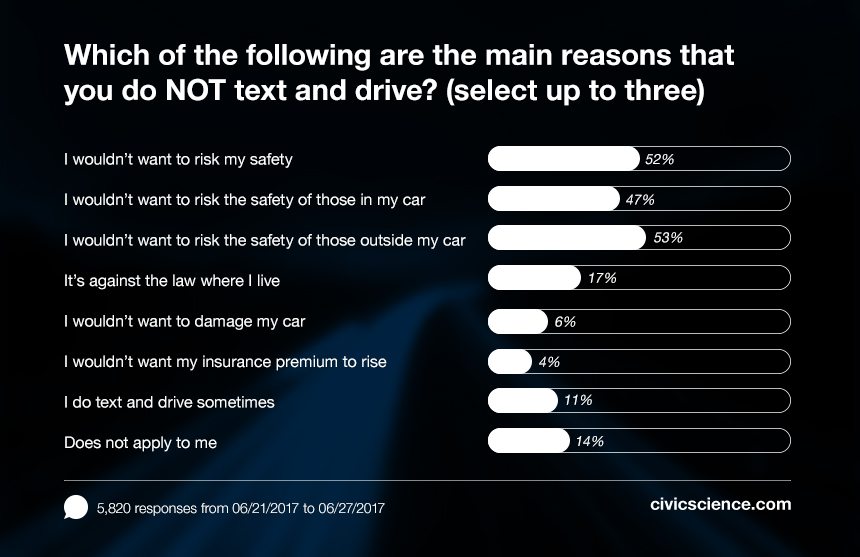The Gist: According to our most recent data, 11% of drivers say they sometimes text and drive. Among those who don’t, three deterrents are top-of-mind: fear for pedestrian safety (53%), fear for the driver’s own safety (52%), and fear for the safety of those inside one’s car (47%).
In a past study at the Virginia Tech Transportation Institute, researchers found that texting while driving is six times more likely to cause a car accident than drunk driving. That said, stories of car crashes that involve driver distraction still saturate the news, and it seems that our addiction to digital devices stops many of us from keeping our eyes on the road.
Naturally, many states and private businesses have initiated campaigns and laws to fight this trend. Some campaigns focus on the damage that distracted driving can have on passengers within the car, while others stress the danger to pedestrians or the driver themselves.
However, there are doubts surrounding the long-term effects of these movements, such as AT&T’s “It Can Wait” Campaign. Maybe it’s because these PSAs are not harnessing the right message. To find out, we asked U.S. adults the top three reasons that they do not text and drive. Here’s what we found:
Among the options, two deterrents reign supreme: fear of hurting those outside of one’s car (i.e. pedestrians), followed by the fear of risking one’s own safety. Refreshingly, only 4% say that one of their main deterrents for not texting and driving is the fear of their insurance premium rising, and only 6% say they wouldn’t want to damage their car.
Though many have argued that laws against distracted driving have little weight or effect, our data seem to assert otherwise. A full 17% of adults say that their local laws are the main reason that they keep their eyes off their phones and on the road.
On a slightly more pessimistic note, it seems that texting while driving hasn’t seen the decline that many of us hoped it would by now. In fact, a 2012 study found that 10% of drivers at least sometimes sent text messages or emails while driving. Unfortunately, our data now present that number at 11%. Unsurprisingly, these distracted drivers are much more likely to be Millennials:
To curb the dangerous trend, PSAs may want to continue emphasizing the aforementioned concerns that have surfaced as top-of-mind when it comes to texting and driving. To reiterate, these concerns are:
1. I wouldn’t want to risk the safety of those outside of my car (53%)
2. I wouldn’t want to risk my safety (52%)
3. I wouldn’t want to risk the safety of those inside my car (47%)










